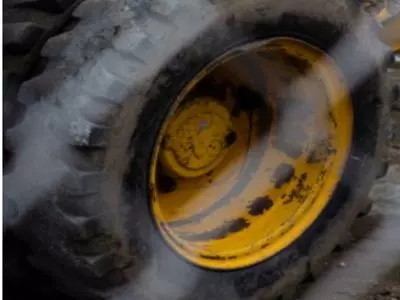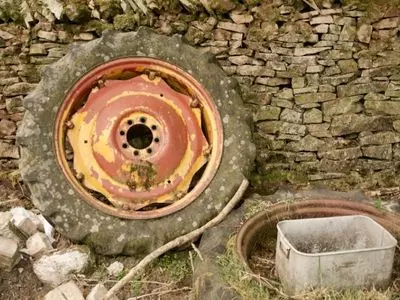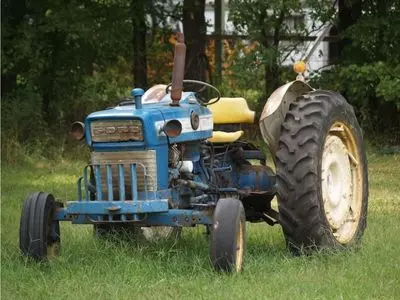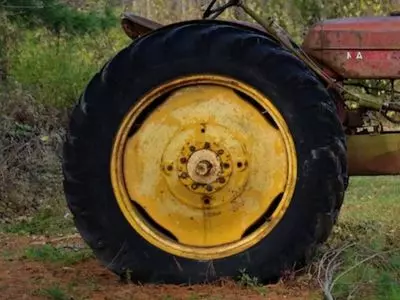No products in the cart.
Tractor
How to Change a Tractor Tire – 3 Basic STEPS
Tractor tires must be replaced at some point. Maybe your tire has burst, has a worn tread, or has a puncture.
Whatever it is, that tire has to get changed.
Changing a tractor tire is similar to changing a car tire in that you have to remove the old tire, put on the new tire, and ensure that it’s pumped properly. However, there are more details involved when it comes to changing a tractor tire.
We have the whole process of how to change a tractor tire right here, so continue reading for a more in-depth step-by-step for changing your tractor tire.
*This post may have affiliate links, which means I may receive commissions if you choose to purchase through links I provide (at no extra cost to you). As an Amazon Associate I earn from qualifying purchases. Please read my disclaimer for additional details.
3 Steps to Change Your Tractor Tire

Follow the below steps to change the tire on your tractor:
1. Take Off the Old Tire
Always park your tractor on level ground to avoid issues later.
- You can use a standard floor jack to lift your tractor. Follow the manufacturer’s instructions when doing so.
- Once you’ve raised your tractor, the valve cap must be removed, and then the air must be released by grabbing the center with a pair of needle nose pliers.
- Before continuing, make sure the tractor tire is flat. A lever may be used to remove beads from a tire. If you lubricate the tire beads and rim seats with water and dish soap, they will be easier to remove from a tractor.
- After the tire has been lubricated you can begin to hit the tire near the rim (don’t hit the rim) until the bead breaks. Repeat that on the other side.
- You can then use the removals slots to grab the edge of the tire and pull it over the rim. Continue to pull the edge of the tire over the rim until the whole tire edge is out from under the rim.
Tire beads that are oiled will be less likely to get damaged. Don’t take the beads off an inflated tire as it’s hazardous.
Keep in mind that your work will be simpler and safer if you have the right equipment. Also, be sure not to pinch or pierce the tube during this process.
Read More: Best Farm Jack. When it comes to farm work, you’ll need a jack that can handle tough tasks. We reviewed the top-ranking farm jacks and here are our thoughts!
2. Install the New Tractor Tire

There is a vast selection of tires designed specifically for farming use.
Before you buy any new tires, make sure to check that they are compatible with your tractor.
Additionally, keep the following in mind:
- The width of the rim correlates with the width of the tire.
- You can see if the tire can go onto the rim by referring to the tractor’s user manual.
Double-check that the tire’s rim is clean and in excellent condition. If the tire’s rim is unclean, a wire brush should be used to clean it.
Do not put a new tractor tire on a dirty or damaged rim. Cracks, significant deformation, and corrosion are all signs of wear and tear.
You may start installing the tractor tire after ensuring it is clean and undamaged:
- The valve or hole should be placed directly in the center of the tractor’s wheel.
- To avoid damaging the valve, set the window for breaking beads away from it. This will also protect the tire bead.
- The tire should be attached to the wheel, and the tire beads should be on the edge of the rim, as this will show you if they’re in place or not.
- Use a lever or other tool to lift the tire bead over the lip of the rim and into the deepest rim well, to install a tire on a wheel.
- After mounting the tire on the wheel, seal up the valve. Tighten up your wheel nut just a little bit.
- Once you have completed the above procedures, inflate the inner tube and insert it into the tire.
3. Inflate the Tractor Tire
When inflating the tractor tire, you must take extreme caution.
If not done correctly, you risk a broken arm or blown tire. To prevent injury wear appropriate gear such as goggles, boots, and earplugs.
When you inflate your tires, keep as far away from the tractor’s wheels as possible.
If something goes wrong, your chances of being injured are considerably reduced in this instance. Inflating with a pressure gun is yet another technique to make things safer.
Here’s a video showing you how to remove and replace a tractor tire:
Read More: How Much Do Tractor Tires Weigh? Replacing your tire may be a two-man job. Here’s how much the average tractor tire weighs!
When Do Your Tractor Tires Need to Be Replaced?

A tractor’s tire quality is directly linked to its performance.
Tires that are worn out, no longer effectively transmit power to the ground, and do not give adequate traction might affect output and fuel usage.
Expensive and inconvenient tractor breakdowns are caused by ignoring the tell-tale signs that it’s time for new tires.
Although there isn’t a specific timeframe in which you should get your tractor’s tires replaced, there are indicators that you can look out for.
Tire Damage
Tractor tires are susceptible to punctures from various causes, including sharp twigs, hidden fence posts, and wandering nails, just to mention a few.
Tires can take a beating, however, modern versions have more rubber to prevent punctures than older models.
You know it’s time to replace your tire when the body plies or belts become visible due to a cut, tear, or puncture.
Tractor tires are susceptible to more than just punctures.
For example, a bulge in a tire indicates impact damage from driving over hidden rocks in a field or on poorly maintained roads.
The casing is likely damaged if your tire has developed a bulge.
Bulging tires cannot be repaired and should always be replaced as soon as possible. If you don’t, it could fail while driving, which would cost you time and be dangerous.
Lack of Air Hold
Tire pressure is essential to a tractor’s performance and getting the most out of your tractor.
Air leaking from the tires results in decreased fuel economy, soil compaction, and a less comfortable ride.
Older tires may have difficulty maintaining proper air pressure for various reasons, such as an old valve stem or a damaged wheel.
It’s time to replace a tire when the trouble of constantly topping up a slowly deflating one becomes too much (or if you don’t want to risk getting a flat).
Dry Rot
Machines inactive for extended periods are especially susceptible to dry rot, which can be brought about by elements like constant exposure to sunlight and dry air or contact with substances like herbicides and pesticides.
When dry rot sets in, it leads to tires that are no longer flexible, have cracks, and a weakened structure.
Tires with dry rot must be replaced.
Conclusion
Replacing a tractor tire is a bit more labor intensive than a car tire, but with the right tools and by taking your time you can easily replace your tire without any issues.

